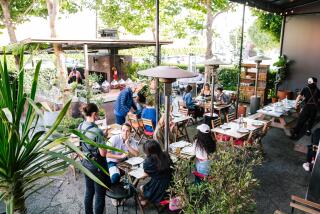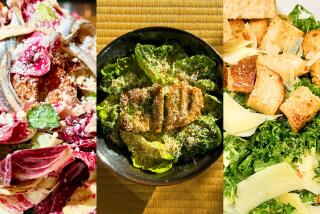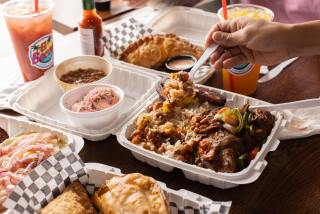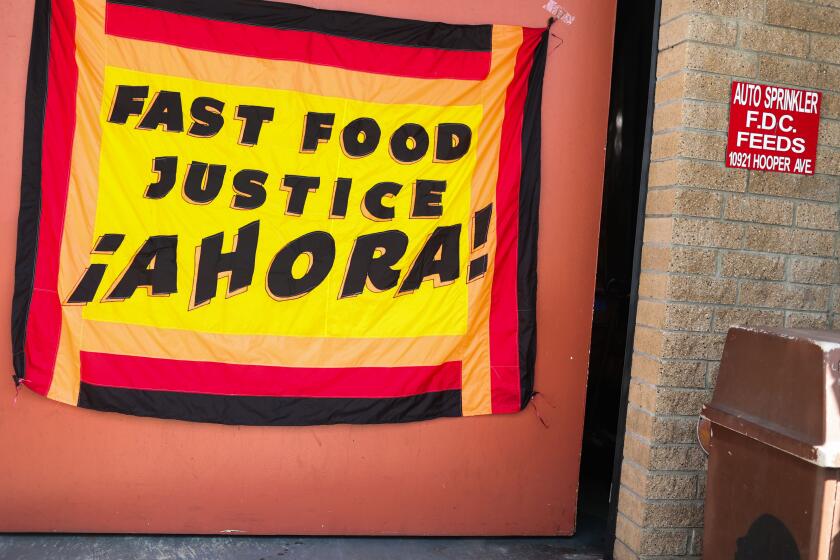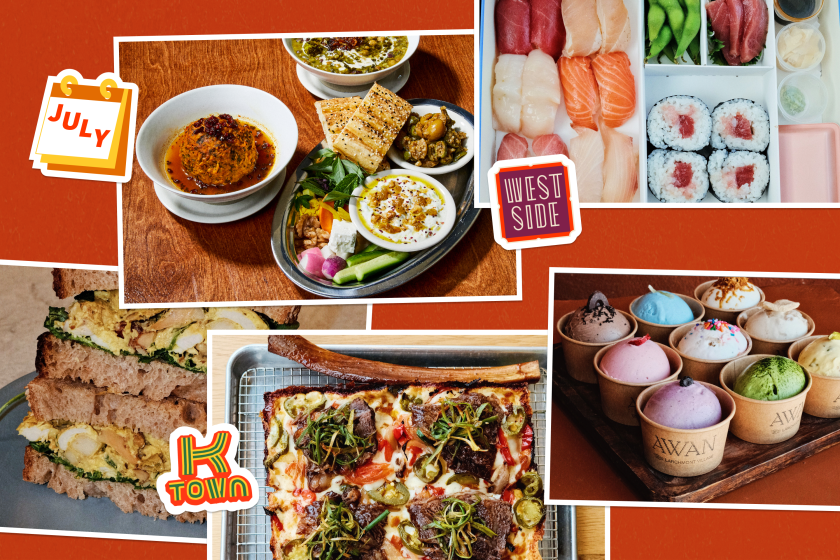THE SPAGOIZATION OF MANHATTAN
“Wolfgang Puck has saved us!”
In “October Blood,” a recently published novel by New York writer Francine du Plessix Gray, a blonde bursts into a New York restaurant and utters those timeless lines. The blonde sits down at a table. “L.A.,” she says. “Nothing to eat for years beyond the limp pasta at Orsini’s, the walking beef at the Wilshire . . . and now! . . . a gastronomic capital!”
The Wall Street Journal said much the same thing about the chef who invented the term California Cuisine when he opened Spago and made pizza chic. “Wolfgang Puck is the man to watch in the restaurant industry,” is how they put it.
This did not go over well in New York, which still likes to consider itself the gastronomic capital of the country, if not the world. They were accustomed to sending chefs West to show us how to do things right, and the very idea that we had something to show them sent shivers up their collective spine. There was clearly only one thing to do: Lure Puck East.
“I tried to make a deal to bring Spago to New York,” says restaurant owner Andre Sfez. “I wanted to do a franchise, a partnership, anything. It is the food of the future.”
There was only one problem: Puck wasn’t interested. A major insurance company offered Puck a site in its big new building. Puck still wasn’t interested.
Restaurateur Warner LeRoy told Puck he had a space for him in New York; Puck turned up his pug nose and turned him down. So what do you do if you can’t get the man himself? You settle for the next best thing: You get his top chefs.
And that is how the head chef of Spago, the pastry chef of Spago and the head chef of Puck’s Santa Monica restaurant, Chinois on Main, all happened to be premiering their brand-new menus in New York on a single week in October. And they were not the only ones creating Spago clones.
Says New York Times critic Bryan Miller: “It’s unbelieveable what’s happening this fall. Earlier in the year all the wood-burning pizza places opened. Now come the more Spago-like places serving two or three unusual pastas, six interesting grills, a few pizzas and a few appetizers. So much mesquite is being burned in this town, the pollution level’s gone up 20%.” Puck himself is not present, but the Spagoization of Manhattan has clearly begun.
Walking around Greenwich Village most people tend to look around them; the proper Brownstones, their doorknobs polished, their window boxes still filled with flowers even in the late fall, almost demand attention. As you walk west on 11th Street, you can’t fail to notice the new restaurant that has suddenly appeared in the midst of these serious buildings; Batons looks frivolous, modern, very Californian. The open kitchen gives it a Spago-like air, and if you peer inside, you’ll see that the man behind the stove looks familiar too. He is Richard Krause, who worked at Spago before becoming head chef at Chinois on Main. Owner Andre Sfez openly admits that when he went looking for a chef, Spago was much on his mind.
“Californian cuisine,” he says in his heavy French accent, “is the best of what people today are cooking. The food is great; it’s what you call healthy. All those grills and vegetables.”
Finding all those vegetables, however, has proven difficult. “It is so easy in L.A.,” says Krause. “You go to the Chinos (of the legendary Chino Ranch in Del Mar) for vegetables. You go to Joey Weiss (of Northern Produce) for produce and to Nelson Lee Moy (of United Food Co.) in Chinatown for fish and ducks. Here I thought, ‘Well, I’ve heard of the Fulton Fish Market, I guess I just get in a taxi and go down there.’ But that’s not the way it’s done. Here you have to order everything over the phone. And then it doesn’t arrive.”
Why, you may be wondering, doesn’t it arrive? The answer is traffic. Although New Yorkers habitually complain about the terrors of Los Angeles traffic, the West Coast manages to deliver. Not so back East.
Says Mark Peel, former head chef at Spago, who has moved to New York to take over the kitchens at Maxwell’s Plum, “New York traffic is horrendous. Things that are supposed to be here in the morning routinely get hung up in traffic and don’t arrive until late afternoon.” Krause adds: “In L.A., if I went down to the market at 7 and there were no scallops, I had all day to find other ones. Here, if the scallops come in late and they aren’t up to my standards, I simply have no scallops.”
At Batons, Krause grills his scallops and serves them in a cabernet butter sauce with carmelized minced shallots. Like most California chefs, he depends heavily on grilling and roasting, and his sauces tend to be quite simple. Cilantro, lime, crisp, spicy, peppers, pizza and Japanese are words that appear with frequency on the menu. Another word that appears frequently is Maui onion.
It was only after the menu was printed that Krause discovered that nobody in New York had ever heard of a Maui onion. “People kept saying sure, sure, but when it came down to it, they didn’t have any. It took me two weeks to find them--and I’m paying $3.80 a pound. I could call up Joey Weiss in Los Angeles and have him ship them out first-class for less.”
Krause’s food was an instantaneous hit. After only two weeks the restaurant was crowded with people happily eating his charred spicy blue-fin tuna with mango, tomato and green onion sauce, his grilled whole red snapper, his goat-cheese pizza and his black ravioli with lobster. “We’ve only had two orders of tuna sent back because they were too rare,” exults Krause. “And people come back four, five, six times.”
“We have a younger clientele than we did at Spago,” says manager Wendy Mathews, another Spago alumnus who works with Krause and shares an apartment with Peel and his wife Nancy Silverton. “I’d say 35% of our clientele is under 30.”
Batons gets what New Yorkers call the “B&T;” crowd--people who take the bridge and tunnel in from Long Island. “Afterwards they go on to Heartbreak, the Palladium, Limelight. And they are dressed more beautifully than anybody I’ve ever seen.”
These beautiful people, says Mathews, like to eat late. “It’s hard to fill the tables here early. Our biggest hours are 10 and 10:30. In L.A. people live so far away that they go to restaurants straight from work. Here they go home, freshen up, eat later. There’s nobody in the restaurant at 6 o’clock.”
At midnight, however, the place is packed. Says owner Andre Sfez: “I know this is a good idea because without any advertising, without any mention in the newspapers, we are already very successful. We are already serving as many people as Spago.”
It is a Monday in November, and it is raining in New York. At Maxwell’s Plum, one of the country’s highest-grossing restaurants (7 million meals served since the opening in 1966), only 350 people have shown up. This makes it a very slow night, and new chef Mark Peel seems discouraged.
Peel was the head chef at Spago from the day that it opened until he left for New York, and his menu would delight any well-fed Angeleno: appetizers include deep-fried calzone filled with roasted red peppers and olives, lime-marinated raw salmon and tuna and black pepper fettucine with asparagus and arugula. The entrees include whole roasted red snapper, grilled pigeon, crisp roasted duck with pears in red wine, baby lamb with fresh rosemary and a whole range of pizzas from a wood-burning oven.
But unlike Krause, Peel is facing some resentment. Maxwell’s Plum had a built-in audience, and some of the old customers aren’t crazy about the new food. “One party tonight sent everything back,” sighs Peel. “They had a Caesar salad that they didn’t like, then an onion consomme. They didn’t like that either; I think they were expecting an onion soup with cheese.” He looks at his wife, pastry chef Nancy Silverton, smiles wryly and adds: “They didn’t like Nancy’s ice cream and cookies either.”
At least they didn’t leave. Some have. On the night the new menu was inaugurated, many people took one look at the menu and walked right out. Many of those who stayed ate hamburgers. “It’s the only thing that’s left from the old menu,” says Peel. Whether customers noticed that the nine-ounce hamburger is now served on homemade buns and accompanied by fresh hot potato chips, he did not say.
“One customer sent back the oysters because they didn’t have cocktail sauce on them,” groans Peel, adding that no good restaurant in Los Angeles serves that catsup and horseradish concoction, but most New York restaurants do. “Even the Oyster Bar! And when it comes to fish I’ve got real trouble. All my training is for medium rare fish. I always sent fish out with a little pink in it. People here look at it and have apoplexy.”
The customers may be critical, but most critics are thrilled. The old Maxwell’s Plum had been reduced by former New York Times critic Mimi Sheraton to a single embarrassing star, and current New York Times critic Bryan Miller admits that he hadn’t visited the restaurant for two years because the food was so dreary.
“The menu,” he says, “was a turgid document. It was anachronistic, like Sgt. Pepper-era food. I went back last night and I was surprised and impressed. The place has come to life, and the staff is really proud of what is going on.”
The restaurant’s owner, Warner LeRoy, is also pleased with the changes. “The reason I hired them in the first place,” he says, “is that they are really dedicated to the kind of food that they cook. Lots of people talk about it, try to copy it, but this style of cooking is not so easy to do. The Peels care, they’ve got character.”
LeRoy himself is something of a character. A Hollywood kid from way back, LeRoy is the son of Mervyn and the grandson of Harry Warner. He delights in saying things like, “This is the desk where my grandfather chopped off heads in Hollywood.”
But chopping things up California-style is proving problematic at the restaurant. “I walked into the kitchen,” says another California chef, “and Mark had told someone to go chop ginger. The guy didn’t know what ginger looked like.”
Peel himself is having problems adjusting to the new situation. “I’m working with an expediter, which is new for me. There’s a guy with a megaphone who shouts the orders as they come in. I’m used to having all the orders written down; at Spago I had a library in front of me. And on weekends we serve about a thousand meals. The most we ever served at Spago was 412--and that was a disaster. “
Says LeRoy: “It’s a hard problem. We do a big volume, and when you only use fresh ingredients, and cook everything to order, you get a long line and a massive army of people chopping vegetables.”
LeRoy claims that this massive army is not really doing anything new, that he has not consciously attempted to serve California cuisine; still he did make up a little card to put on the tables. It says: “Introducing two of America’s greatest chefs, previously at the renowned Spago in Los Angeles.”
How does Puck feel about all this? He is busy planning his own new restaurant in Los Angeles; it will be completely different. “The problem is that at this rate it will be like the way nouvelle cuisine was in in 1980. Everywhere you went it was beurre blanc or beurre rose. Now every restaurant has grilled tuna with basil. It gets boring--too many places are the same.”
And, there are a lot of places.
Says Miller: “It goes on and on. These places are opening every other week.” The first California-style restaurant in New York, Jam’s, was opened by former Michael’s chef Jonathan Waxman almost two years ago. It was elegant, expensive, an immediate hit--but nobody copied it. But the arrival of the Spago-style has started an explosion.
Some even admit where the inspiration came from.
“The guy who owns Canastel, downtown in New York,” says Puck, “came into Spago and said, ‘We copied the style of Spago. And I want to thank you. We’re so successful, we make so much money.’ ” Says Miller: “People are standing in the street at 2 a.m. to get in.”
Think of it--those snobbish New Yorkers standing in line for food we have been eating for years. All fall they have been bragging about the number of new restaurants that have opened, but the truth is, they are just making up for lost time. When it comes to food fashion, there has been a virtual revolution. While New York dresses up in yesterday’s dishes, Los Angeles sits at the table, fork poised, waiting to see what new styles will come out of the kitchen.
More to Read
Eat your way across L.A.
Get our weekly Tasting Notes newsletter for reviews, news and more.
You may occasionally receive promotional content from the Los Angeles Times.
